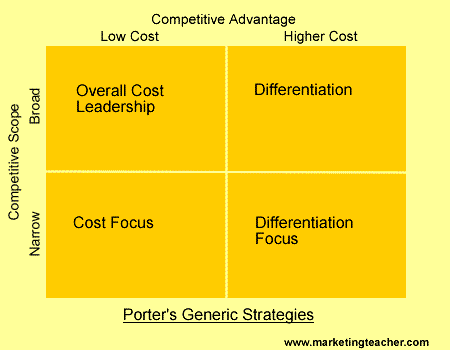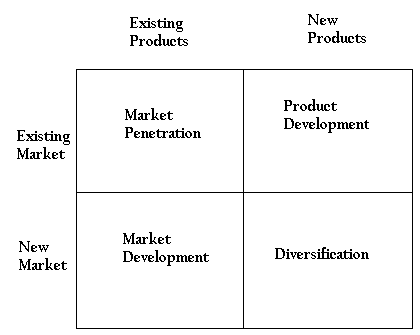Choosing what position to take in the market in which a business function is an extremely important part of a company’s strategy. Michael Porter identified three basic strategies which cover the range of positions that a business can take to compete in the market.
These three strategies are
Cost Leadership
According to this strategy, a business competes by applying cost-cutting measures to all levels of its value chains. A low-cost producer will be hitting the highest profits in a market that is selling standardized goods at relatively standardized rates. In such a situation low cost of production is not reflected in lower prices, but the company then has a bigger margin of profit which it can reinvest back into the business. In other situations however a low-cost producer’s edge in the market might be that the producer is offering the good at the cheapest rates.
Differentiation
This strategy implies that a business is offering a unique addition to the product that is being sold in the market and in such a way that it adds value to the product from the customer’s perspective. This value addition can be in any form, providing better services, adding a new feature to the product, or maybe even giving more variety to the customer. If the value addition is perceived as valuable by the customer then the producer will be able to transfer the costs to the customer or maybe even get a higher margin of profit.
Focus Strategy
The focus strategy involves identifying various market segments and then choosing a narrow segment and modifying the product to suit that particular segment. This strategy might work for smaller businesses that are struggling to compete with larger businesses in terms of efficiency or even variety. Identifying a narrow segment means that businesses can understand that segment thoroughly and be able to serve it better than a larger more broad-based competitor.
Each strategy carries with it its own culture and therefore t might be hard and risky to implement more than one strategy in the same business, however, narrowing one’s focus to just one strategy might also end up hurting the business.
The model below serves to summarize the model:

If we look at where Du stands when considering Porter’s strategies we realize that the actual implementation of the model is slightly more complex. Looking at it from one perspective we can see that Du is focusing on differentiating its product from those in the market. It seeks to tailor its products according to the needs of the various customers and to value add o the product to make it more appealing to the customer. However, on the other Du has been increasing shareholder value through profit maximization by keeping costs low. It has even partnered with Nokia to keep its costs as low as possible. This implies a cost focus. This would imply two diverging strategies which are not recommended by Porter. However, in the case of Du, we can see that it has certain advantages which permit it to follow both paths. Du has a significant edge because it receives a significant government subsidy. In addition to this government regulations have created tough entry barriers for competition in the market giving Du a significant edge.
Ansoff Matrix
Ansoff Matrix was introduced by Igor Ansoff to categorize a business’s growth strategy by taking a combination of options involving existing and new products and markets.

Market Penetration- This is the least risky option for growth since the business is sticking to the products and the markets that it knows. The business is seeking to increase its market share. This strategy cannot be applied indefinitely and eventually continued growth will require other strategies.
Market Development- This means that the business is selling the same product but looking at new market segments to which to sell. This strategy will work best if the core competency of the business is products and not customer segments.
Product Development- Product Development is when a company sticks to the same market but explores new products. Unlike the Market, the Development strategy will work if the business’s core competency is its customer’s and not its product.
Diversification-This is the riskiest of all strategies since a business is making new products to sell to new customers. It’s a completely unfamiliar area
If we look at Du then basically we can place them in two of these categories. The first one is to increase penetration in the market. As referred to earlier in the paper, Du plans to increase its penetration in the UAE market from the present 2.498 million active customers to 4 million subscribers in the next three years. This indicates a clear strategy of market penetration, which simply involves increasing market share (which Du intends to increase from 25.5% to 50 % in the coming years). However, in addition to this Du intends to pursue a strategy of product development. Du realizes that because of the variety of the products in the market and the fact that customers are becoming increasingly demanding, means that new products need to be evolved. This implies a strategy of product development, which means selling new products to the same market segment.
References
Generic Strategies – Michael Porter (1980) Marketing Teacher. Web.
Porter’s Generic Strategies Mindtools. Web.
Porter’s Generic Strategies QuickMBA. Web.
The Ansoff Matrix ‘Mindtools’. Web.